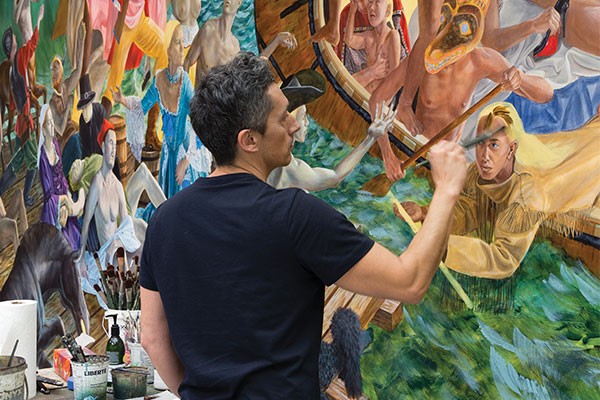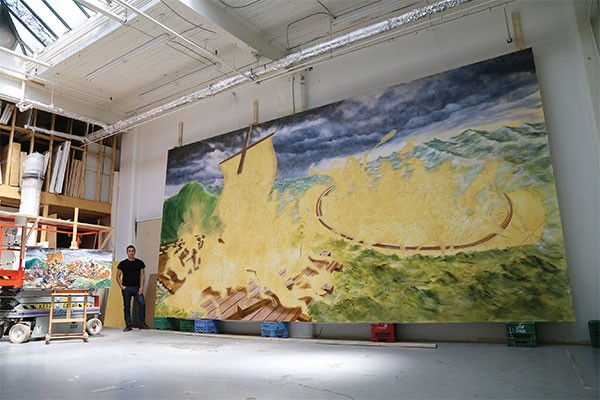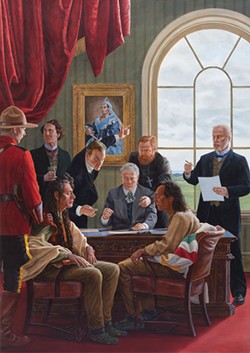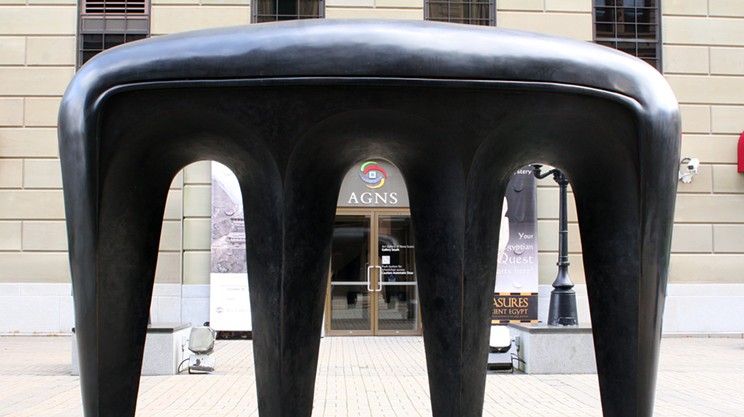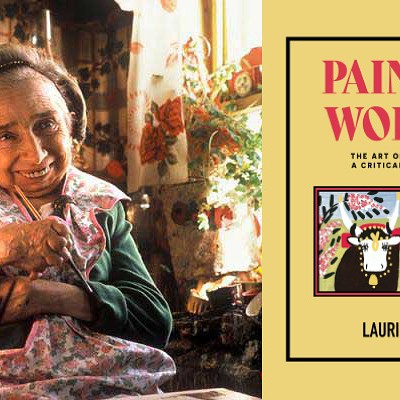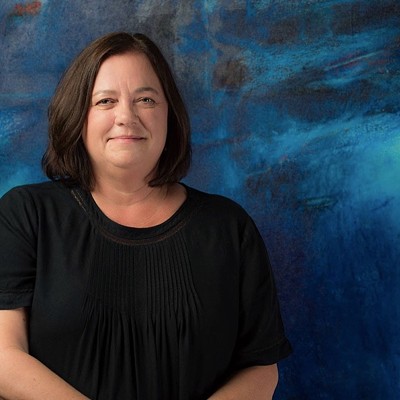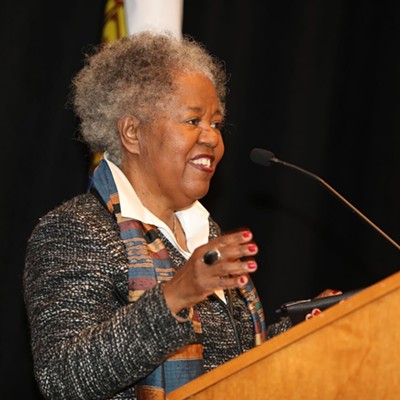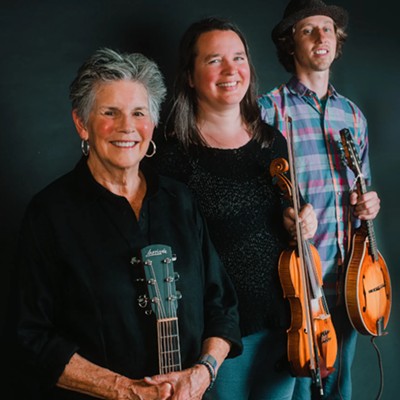Kent Monkman is known for working on a monumental scale, and his recent work is as ambitious as ever. With the help of his Toronto studio, the Cree artist and his team of assistants (like a renaissance master and workshop) create stunning, giant canvases that reimagine the genre of history painting. History painting has less to do with historical subject matter (though Monkman certainly deals with that, and in spades), but rather is a genre of painting that deals with narrative—a moment of action painted in a realistic style to tell a story. These museum favourites—large, pristine landscapes and portraits of lauded European and North American leaders—are subverted and reimagined under Monkman's brush.
The central figure in most of Monkman's artwork is Miss Chief Eagle Testickle, Monkman's time-travelling and gender-fluid alter-ego. Since her first appearance in the early 2000s, dressed like 1970s Half Breed-era Cher in long white headdress and pink fuck-me-pumps (and little else), Miss Chief has sashayed her way through video works, performances, paintings and more. She has loved and lured Canada's founding fathers, performed in Wild West shows and toed the delicate (and unequal) relations between Indigenous people and Canadians.
In Shame and Prejudice: A Story of Resilience, on view at the Art Gallery of Nova Scotia until December 16, Monkman has arranged Canada's colonial history into nine parts he calls "chapters of Miss Chief's memoirs." Created to coincide with last year's Canada 150 celebrations, the works in Shame and Prejudice tell subversive and important histories through paintings, large-scale dioramas and historic objects borrowed from museums.
"When Barbara Fischer invited me in 2014 to create a Canada 150 project for the Art Museum at the University of Toronto, I leapt at the opportunity to represent a critical perspective on the last 150 years of history of Turtle Island," Monkman writes in the exhibition's accompanying text. "As Canadians celebrate the big birthday of confederation in 2017, we cannot forget that the last 150 years have been the most devastating for Indigenous people in this country: Deliberate starvation, the reserve system, the legacy of incarceration, the removal of children to residential schools and the Sixties Scoop, sickness and disease, persistent third world housing conditions on reserves, contemporary urban disenfranchisement, violence and poverty. The fact that Indigenous people continue to survive all of this is a testament to our strength."
Shame and Prejudice: A Story of Resilience begins in New France in the baroque opulence of the fur trade, with even the beavers themselves living luxuriously. In a group of paintings and small drawings, a colony of beavers can be seen drinking from wine glasses and pissing in golden arcs, lounging in the elaborate woven structure Monkman refers to as a "beaver condo," before they are butchered by French trappers.
The luxury continues in the adjoining room, where a dining table is richly decorated with china, candelabras and plastic finger food. Wedgwood plates commemorating the Plains of Abraham, cigar boxes with the Queen's face and china made of crushed buffalo bones sit under a plexiglass topper.
At the tail-end of the table, outside of the encased staged meal, a series of blue-and-white plates are strewn with small white bones. Beloved Newfoundland painter Mary Pratt once said that you needed to have a sacrifice to have a party, but these plates—white men perched on mountains of skeletons showing the mass slaughter of buffalo; the bones strewn across the plates in reference to the intentional starvation of Indigenous people—articulate clearly who this party was for.
While part of Miss Chief's role is to illustrate such horrors and inconvenient truths, Monkman does not imagine her to be much of a saint. Like any trickster character, she is subject to whims and vices, and every now and then finds herself in a sticky situation.
Monkman describes her purpose as a supernatural being, "to help Indigenous people negotiate this relationship with the bearded faces—the white people who came," he says from Toronto.
But her negotiations are not always diplomatic. She has missteps, ill-advised dalliances with colonial leaders, but even with mascara streaming down her face, she is a figure in control.
In "The Daddies" (2016) a nude Miss Chief addresses the fathers of confederation while sitting on a Hudson's Bay striped blanket. In the voice of Miss Chief, Monkman's collaborator Gisèle Gordon writes: "Naked, I am at my strongest. I did not get where I am today by being a wallflower." Miss Chief's over-the-top sexuality is an important nod to the complex sexual and gender identities that flourished in Indigenous communities prior to colonization, as well as a tool she uses to play with these powerful men. In "The Bears of Confederation" (2016) she calls on bear spirits to help her in her dominatrix duties: Punishing and pleasuring the white, fat, leather-clad daddies that divided up what came to be known as Canada.
But the stunning work in the next room, "The Scream" (2017), is no place for Miss Chief's brand of campy humour. In the accompanying text, this chapter of Miss Chief's memoir is almost blank. Titled "Forcible transfer of Children," she (Gordon) writes, "This is the one I cannot talk about. The pain is too deep. We were never the same."
Exploring residential schools and the forcible removal of children during the Sixties Scoop, "The Scream" is an intensely emotional piece. The setting is a 20th century reservation. Women and children are scattered across the massive canvas while Mounties, nuns and priests drag the children from their mothers. The central figure is one such mother, her face twisted into an agonizing scream, while Mounties pull her hair and clothes, her child in the arms of a black-robed priest.
The painting is large, the figures at a human scale. Across from the painting, a wall is hung with handmade cradleboards that were used for carrying infants. They are hung in a grid, some in plain grey metal—a stark contrast to the cheery carved and painted family artifacts—and for others there is merely a chalk outline of a board, representing all of the children who were lost.
In most of Monkman's work the casualties are pasty cowboys or modern-art masterworks mangled in car wrecks ("causalities of modernity," he says), but in these new paintings he does not shy away from representing the pain felt by Indigenous people, hoping viewers will have empathetic and emotional responses to these images.
The painting "Death of a Virgin (After Caravaggio)" (2016), where he explores the crisis of teen suicide among Indigenous youth as well as missing and murdered Indigenous women, notes this shift.
"I needed to find the language of painting that I could come to that without levels of irony," says Monkman, "and just meet it directly and give it the power, authority and the force that it needed."
These stories are too painful to talk about, but Monkman is finding a way. Just over a year after Canada 150 celebrations, the confederation's sesquicentennial, Monkman is still finding Canada's self-interested colonial histories a fertile ground to work with, and opportunities to tell the stories that didn't make it into history books.
"In general Canadians are receptive and eager to learn and come to this project with an open mind and realize how much of the histories—Indigenous experiences and histories of this country—have been whitewashed and kept from them deliberately," he says. "There's a lot of people that have been educated through this school system—even through university—that never learned anything about residential schools. Or some of the other policies—colonial policies—that had really affected genocide on Indigenous people."
Western painting has always been a blend of fact and fiction. Old kings composed to look young and strong, unjust wars painted as heroic, murderers made martyrs. What art alone can teach us about history is always at the mercy of the artist.
But by taking the reins of art history—by inserting Indigenous people and their histories into these tableaux and blowing up the colonial narratives that have worked to erase them—Monkman is both historian and anarchist. The scenes he presents are fact and fiction, hilarious and heartbreaking, and in making them he is paving a way for the rupture of how we understand of the story of Canada. Whether it's your first time seeing your histories painted, or the first time you're seeing the authority of your histories questioned, Monkman's work is certainly a first.
Mollie Cronin is a freelance arts writer and illustrator from Halifax who publishes cartoons under the name Art Brat Comics (@art.brat.comics), which you can also sometimes find in The Coast.

